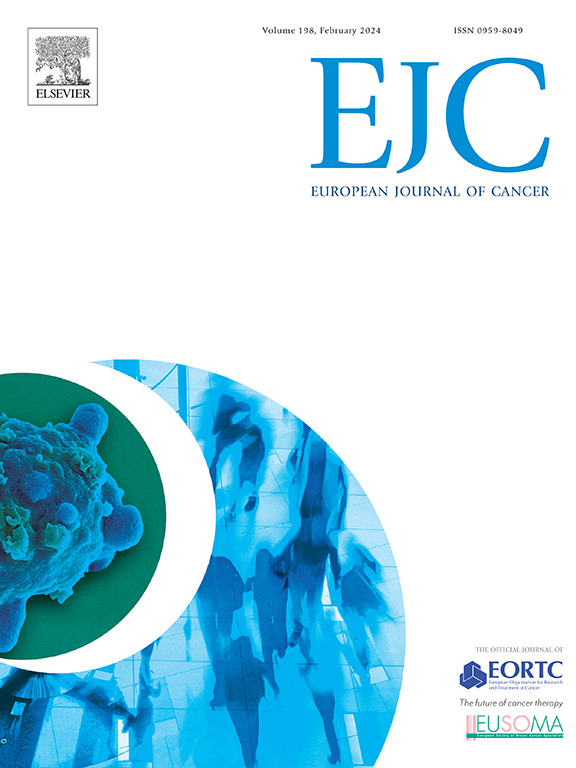Reconsidering the surgical approach in cutaneous melanoma: does wide local excision after a complete diagnostic excision reduce the risk of recurrence?
IF 7.6
1区 医学
Q1 ONCOLOGY
引用次数: 0
Abstract
Objectives
This study examines whether wide local excision (WLE) after complete diagnostic excision improves recurrence-free survival (RFS) in clinical stage I/II primary cutaneous melanoma.
Background
Since the 1950s, melanoma treatment has included a two-step surgical approach, involving diagnostic excision followed by WLE. WLE aims to achieve locoregional disease control by eliminating potential microsatellites and, thus, minimising the risk of locoregional recurrence and melanoma-related death. However, its impact on RFS is unclear, while it adds morbidity and costs.
Methods
This retrospective nationwide cohort study analysed pathology reports of a Dutch population-based cohort of newly diagnosed invasive cutaneous melanoma patients who underwent a complete diagnostic excision between January 1st, 2012, and December 31st, 2013. Data were obtained from the Dutch Nationwide Pathology Database (PALGA). Patients with completely excised superficial spreading and nodular melanoma located on the trunk and upper and lower extremities were included. Cox regression showed no significant RFS benefit from WLE.
Results
A total of 6189 eligible patients were included. WLE was not performed in 271 patients (4.4 %). Of those undergoing WLE (n = 5918), residual dermal invasive tumour cells were identified in 0.7 % (n = 44/5918). The overall recurrence rate was 7.7 % (n = 477/6189). Recurrence rates were 7.6 % for WLE cases (local: 2.5 %, nodal: 4.0 %, distant: 1.2 %) and 10.3 % when WLE was omitted. Cox regression showed no significant RFS benefit from WLE.
Conclusion
WLE does not significantly improve RFS in patients with completely excised cutaneous superficial spreading and nodular melanoma on the trunk or extremities.
重新考虑皮肤黑色素瘤的手术方法:在完全诊断性切除后广泛局部切除能降低复发风险吗?
目的:本研究探讨完全诊断性切除后广泛局部切除(WLE)是否能提高临床I/II期原发性皮肤黑色素瘤的无复发生存率(RFS)。背景:自20世纪50年代以来,黑色素瘤的治疗包括两步手术方法,包括诊断性切除和WLE。WLE旨在通过消除潜在的微卫星来实现局部区域疾病控制,从而最大限度地减少局部区域复发和黑色素瘤相关死亡的风险。然而,它对RFS的影响尚不清楚,但它增加了发病率和成本。方法:这项回顾性全国队列研究分析了2012年1月1日至2013年12月31日期间接受完全诊断性切除的荷兰新诊断浸润性皮肤黑色素瘤患者的病理报告。数据来自荷兰全国病理数据库(PALGA)。患者完全切除浅表扩散和结节性黑色素瘤位于躯干和上肢和下肢。Cox回归显示WLE对RFS没有显著的改善。结果:共纳入6189例符合条件的患者。271例患者(4.4 %)未行WLE。在接受WLE的患者中(n = 5918),残留的真皮侵袭性肿瘤细胞占0.7 % (n = 44/5918)。总复发率为7.7 % (n = 477/6189)。遗漏WLE的复发率为7.6% %(局部:2.5 %,淋巴结:4.0 %,远处:1.2 %),而遗漏WLE的复发率为10.3% %。Cox回归显示WLE对RFS没有显著的改善。结论:WLE不能显著改善躯干或四肢完全切除的皮肤浅表扩散和结节性黑色素瘤患者的RFS。
本文章由计算机程序翻译,如有差异,请以英文原文为准。
求助全文
约1分钟内获得全文
求助全文
来源期刊

European Journal of Cancer
医学-肿瘤学
CiteScore
11.50
自引率
4.80%
发文量
953
审稿时长
23 days
期刊介绍:
The European Journal of Cancer (EJC) serves as a comprehensive platform integrating preclinical, digital, translational, and clinical research across the spectrum of cancer. From epidemiology, carcinogenesis, and biology to groundbreaking innovations in cancer treatment and patient care, the journal covers a wide array of topics. We publish original research, reviews, previews, editorial comments, and correspondence, fostering dialogue and advancement in the fight against cancer. Join us in our mission to drive progress and improve outcomes in cancer research and patient care.
 求助内容:
求助内容: 应助结果提醒方式:
应助结果提醒方式:


